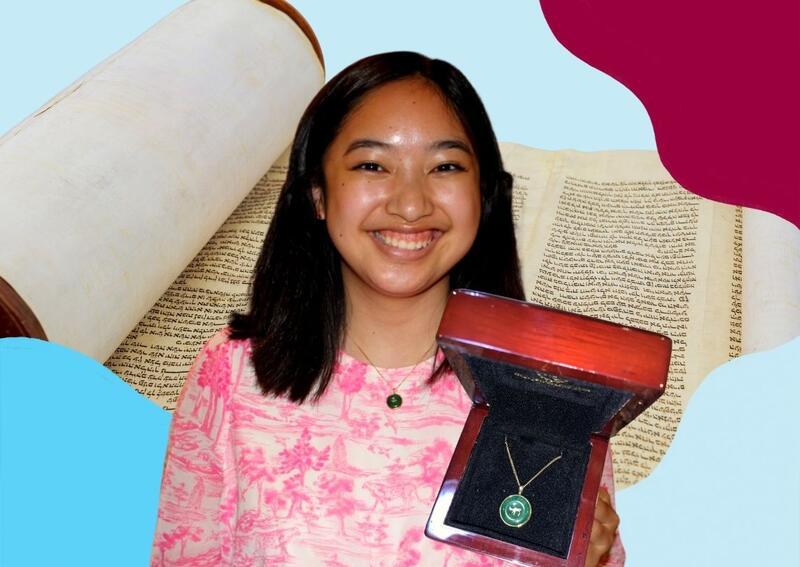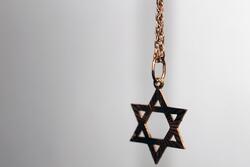My Necklace is a Symbol of My Jewish-Chinese Feminist Identity
I can count on one hand how many Chinese-Jewish female adoptees I know closely. Among those in this handful, the fellow adoptee I’ve known the longest is Hannah. Incredibly, our mothers adopted both of us at the age of fifteen months and at the same location on April 5, 2005. Due to this common history, our families have maintained a uniquely close bond. We’ve stayed in contact, visiting each other every few years, celebrating our shared “Gotcha Day” together and, importantly, attending each other’s bat mitzvahs. For my bat mitzvah, Hannah gifted me a beautiful chai necklace adorned and inlaid on a smooth, pristinely-polished circle of jade. As I’ve learned about the feminist symbolism of both chai in Judaism and of jade in China, this necklace has become my most prized possession as a Chinese-Jewish feminist.
Perfectly melding my Chinese and Jewish feminist identities (and a gift from a friend who shares in them,) the necklace has a powerful, multi-cultural presence. Both Chinese and Jewish cultures regard the components of the necklace as significant. Ancient Chinese society regarded jade as the most precious stone, associating it with purity and moral integrity, and often used it in ritual objects. Anthropological studies on ancient Chinese society have linked the use of jade to emancipation ceremonies for Chinese women, like the “combing up” ceremony in China’s oldest feminist movement. The traditional combing up ceremony symbolized that a girl had reached the age to permit an arranged marriage. The patriarchal, patrilineal family structure dictated by Confucian ethics taught the inferiority of women and became the basis for sexual discrimination and subjection of Chinese women and girls. According to Confucius, a virtuous woman had three obediences: to her father and brothers before marriage, to her husband after marriage, and to her son if she was widowed. In the early nineteenth century, a small group of feminists vowed to remain “self-combed women,” or zishunu, leaving their parents’ home to work without marrying. This feminist version of the traditional comb up ceremony granted women autonomy by no longer requiring marriage and therefore inspiring independence. The custom, which was a form of marriage resistance, involved the use of a jade comb and meant freedom from the Chinese societal norm of required marriage and the suppression of women.
Chai has a similarly intriguing history. In addition to chai’s English translation to “life,” chai is associated with the value of eighteen according to the gematria, a mystical Jewish tradition that assigns a numerological value to Hebrew letters. The word is spelled with the letter chet, which corresponds with eight, and yud, which corresponds with ten. In kabbalistic texts, the value of eighteen is supposed to direct an “energy of equality,” or, in this case, transition for women from dependence and inequality to independence and full equality with men. I don’t pretend to understand the nuances of kabbalah, but chai and its numerical value of eighteen have a long-standing symbolic, feminist history in religious texts. I was even able to find a jewelry designer, Liza Cowan, who sells a Jewish feminist button that features a combination of a Hebrew chai, a Star of David, and a Labrys axe. I’ve realized that my chai necklace is badass, and I feel like one when I wear it.
My Chinese heritage has made me more aware of sexism and has strengthened my feminist identity. My abandonment in China was the result of China’s one-child policy, which reinforced the idea that female babies are less valuable than male babies who carried a cultural and financial weight in China’s patriarchal system. Under this policy, families in China were forced to abandon their female babies, and a demographic imbalance in the female-to-male ratio arose, further reducing the birthrate in China. As a result, after decades of enforcement, China modified the policy and recently began to allow more than one child in many provinces. As my identity is tangled in the legacy of the one-child policy, I’ve come to fully embrace my identity as a Chinese-Jewish feminist. With the awareness of my origins and the fact that I’m a product of this policy, I hope to continue to teach, research, and provide public services related to sexual and reproductive health disparities.
Similar to my Chinese heritage, Judaism is traditionally a patriarchal religion relegating women to a lower status than men. Examples are plentiful, from separate seating for women in synagogue to women being responsible for preparing food (while male rabbis regulated the practice of Jewish dietary laws). Fortunately, since the mid-20th century, Jewish women have achieved greater equality within Judaism in many religious environments and in more secular spaces. While there has been significant progress in achieving equality and this progress has made me immensely proud of my Judaism, there continues to be a need for Jewish feminists, like myself, to carry on the dialogue of reinterpreting Jewish texts to bring women’s points of view to the forefront. My bat mitzvah is just one of many ways I've sought to bring my voice into Jewish spaces. It represents how I am shaping myself as a feminist that is both Chinese and Jewish. It represents how I am beginning a new tradition for my immediate family and future generations as the women of past generations didn't have bat mitzvahs.
I wear my cherished chai necklace at every event, class, and religious service because it’s a reminder of these cherished roots. My Chinese-Jewish feminist identity is most adeptly captured by my necklace, not only because a fellow Chinese-Jewish female adoptee gifted it to me, but because it was gifted as a bat mitzvah present. As I delve deeper into what my Chinese-Jewish feminist identity is and how I can make meaningful contributions to all the justice-seeking spaces I inhabit, I realize that being Chinese and Jewish is a keystone to my feminist identity.
This piece was written as part of JWA’s Rising Voices Fellowship.








Brilliant just like Ms Amanda
Smiles
I am in awe of Amanda and this article. I have known Amanda and her Family even before she was born. I was honored to assist in her becoming a Bat Mitzvah, and continue our friendship whenever I can!! I know that with young people like this, we will survive this precarious time with new understanding, philosophy and
Gemilut Chesed - loving kindness!